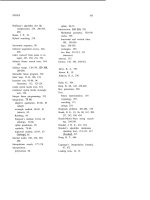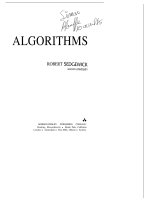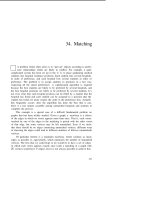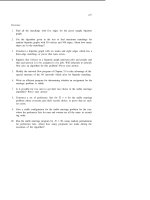Tài liệu Thuật toán Algorithms (Phần 55) ppt
Bạn đang xem bản rút gọn của tài liệu. Xem và tải ngay bản đầy đủ của tài liệu tại đây (62.61 KB, 10 trang )
PROBLEMS
running the given program on the given input, so it produces a solution to an
instance of the given problem. Further details of this proof are well beyond
the scope of this book. Fortunately, only one such proof is really necessary:
it is much easier to use reduction to prove NP-completeness.
Some
NP-
Complete
Problems
As mentioned above, literally thousands of diverse problems are known to be
NP-complete. In this section, we list a few for purposes of illustrating the
wide range of problems that have been studied. Of course, the list begins
with
and includes
traveling salesman
and
Hamilton cycle, as
well
as longest path. The following additional problems are representative:
PARTITION: Given a set of integers, can they be divided into two sets
whose sum is equal?
INTEGER LINEAR PROGRAMMING: Given a linear program, is there
a solution in integers?
MULTIPROCESSOR SCHEDULING: Given a deadline and a set of
tasks of varying length to be performed on two identical processors can
the tasks be arranged so that the deadline is met?
VERTEX COVER: Given a graph and an integer N, is there a set of
less than N vertices which touches all the edges?
These and many related problems have important natural practical applica-
tions, and there has been strong motivation for some time to find good algo-
rithms to solve them. The fact that no good algorithm has been found for any
of these problems is surely strong evidence that P NP, and most research-
ers certainly believe this to be the case. (On the other hand, the fact that
no one has been able to prove that any of these problem do not belong to P
could be construed to comprise a similar body of circumstantial evidence on
the other side.) Whether or not P = NP, the practical fact is that we have at
present no algorithms that are guaranteed to solve any of the NP-complete
problems efficiently.
As indicated in the previous chapter, several techniques have been devel-
oped to cope with this situation, since some sort of solution to these various
problems must be found in practice. One approach is to change the problem
and an “approximation” algorithm that finds not the best solution but
a solution that is guaranteed to be close to the best. (Unfortunately, this is
sometimes not sufficient to fend off NP-completeness.) Another approach is
to rely on “average-time” performance and develop an algorithm that finds
the solution in some cases, but doesn’t necessarily work in all cases. That is,
while it may not be possible to an algorithm that is guaranteed to work
well on all instances of a problem, it may well be possible to solve efficiently
virtually all of the instances that arise in practice. A third approach is to work
534
CHAPTER 40
with “efficient” exponential algorithms, using the backtracking techniques
described in the previous chapter. Finally, there is quite a large gap between
polynomial and exponential time which is not addressed by the theory. What
about an algorithm that runs in time proportional to or
All of the application areas that we’ve studied in this book are touched
by NP-completeness: there are NP-complete problems in numerical applica-
tions, in sorting and searching, in string processing, in geometry, and in graph
processing. The most important practical contribution of the theory of
completeness is that it provides a mechanism to discover whether a new prob-
lem from any of these diverse areas is “easy” or “hard.” If one can find an
efficient algorithm to solve a new problem, then there is no difficulty. If not,
a proof that the problem is NP-complete at least gives the information that
the development of an efficient algorithm would be a stunning achievement
(and suggests that a different approach should perhaps be tried). The scores
of efficient algorithms that we’ve examined in this book are testimony that we
have learned a great deal about efficient computational methods since Euclid,
but the theory of NP-completeness shows that, indeed, we still have a great
deal to learn.
535
Exercises
1.
2.
3.
4.
5.
6.
7.
8.
9.
10.
Write a program to find the longest simple path from x to y in a given
weighted graph.
Could there be an algorithm which solves an NP-complete problem in
an average time of N log N, if P NP? Explain your answer.
Give a nondeterministic polynomial-time algorithm for solving the PARTI-
TION problem.
Is there an immediate polynomial-time reduction from the traveling sales-
man problem on graphs to the Euclidean traveling salesman problem, or
vice versa?
What would be the significance of a program that could solve the traveling
salesman problem in time proportional to
Is the logical formula given in the text satisfiable?
Could one of the “algorithm machines” with full parallelism be used to
solve an NP-complete problem in polynomial time, if NP? Explain
your answer.
How does the problem “compute the exact value of fit into the
NP classification scheme?
Prove that the problem of finding a Hamilton cycle in a directed graph is
NP-complete, using the NP-completeness of the Hamilton cycle problem
for undirected graphs.
Suppose that two problems are known to be NP-complete. Does this
imply that there is a polynomial-time reduction from one to the other, if
536
SOURCES for Advanced Topics
Each of the topics covered in this section is the subject of volumes of
reference material. From our introductory treatment, the reader seeking more
information should anticipate engaging in serious study; we’ll only be able to
indicate some basic references here.
The perfect shuffle machine of Chapter 35 is described in the 1968 paper
by Stone, which covers many other applications. One place to look for more
information on systolic arrays is the chapter by Kung and Leiserson in Mead
and Conway’s book on VLSI. A good reference for applications and implemen-
tation of the FFT is the book by Rabiner and Gold. Further information on
dynamic programming (and topics from other chapters) may be found in the
book by Hu. Our treatment of linear programming in Chapter 38 is based on
the excellent treatment in the book by Papadimitriou and Steiglitz, where all
the intuitive arguments are backed up by full mathematical proofs. Further
information on exhaustive search techniques may be found in the books by
Wells and by Reingold, Nievergelt, and Deo. Finally, the reader interested
in more information on NP-completeness may consult the survey article by
Lewis and Papadimitriou and the book by Garey and Johnson, which has a
full description of various types of NP-completeness and a categorized listing
of hundreds of NP-complete problems.
M. R. Garey and D. S. Johnson, Computers and Intractability: a Guide to the
Theory of NP-Completeness, Freeman, San Francisco, CA, 1979.
T. C. Hu, Combinatorial Algorithms, Addison-Wesley, Reading, MA, 1982.
H. R. Lewis and C. H. Papadimitriou, “The efficiency of algorithms,” Scientific
American, 238, 1 (1978).
C. A. Mead and L. C. Conway, Introduction to VLSI Design, Addison-Wesley,
Reading, MA, 1980.
C. H. Papadimitriou and K. Steiglitz, Combinatorial Optimization: Algorithms
and Complexity, Prentice-Hall, Englewood Cliffs, NJ, 1982.
E. M. Reingold, J. Nievergelt, and N. Deo, Combinatorial Algorithms: Theory
and Practice, Prentice-Hall, Englewood Cliffs, NJ, 1982.
L. R. Rabiner and B. Gold, Digital Signal Processing, Prentice-Hall, Englewood
Cliffs, NJ, 1974.
H. S. Stone, “Parallel processing with the perfect shuffle,” IEEE Transactions
on Computing, C-20, 2 (February, 1971).
M. B. Wells, Elements of Combinatorial Computing, Pergaman Press, Oxford,
1971.
Index
Abacus, 528.
Abstract data structures, 30, 88,
128, 136.
adapt (integration, adaptive
quadrature), 85.
Additive congruential generator
(randomint), 38-40.
add (polynomials represented
with linked lists), 27.
add (sparse polynomials), 28.
Adjacency lists, 3788381, 3822
383, 391-392, 410-411, 435.
Adjacency matrix, 3777378, 384,
410-411, 425, 435, 493, 515.
Adjacency structure; see ad-
jacency lists.
(graph input, adjacency
lists), 379.
adjmatrix (graph input, ad-
jacency matrix), 378.
Adleman, L., 301, 304.
A. V., 304.
Algorithm machines, 4577469.
All-nearest-neighbors, 366.
All-pairs shortest paths, 4922494.
Analysis of algorithms, 12-16, 19.
Approximation algorithms,
524, 533.
Arbitrary numbers, 33.
Arithmetic,
Arrays, 24.
Articulation points, 390-392,
430.
Artificial (slack) variables, 503,
509.
Attributes, 335.
Average case, 12-13.
trees, 198.
B-trees, 228-231, 237.
Backtracking,
Backward substitution, 60, 62
(substitute), 64.
Balanced merging,
1566161.
Balanced trees, 187-199, 237,
355.
Basis variables, 504.
Batcher, K. E., 4633465.
Bayer, R., 228.
Bentley, J. L., 370.
Biconnectivity, 390-392, 429.
537









